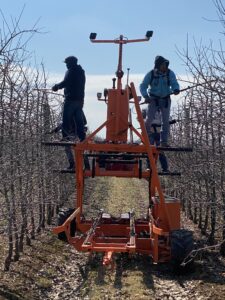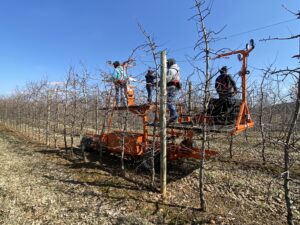Have you ever wondered why fruit trees are pruned before every season? It may not seem like a daunting task, but its one of the most labor intensive jobs of the spring. We have over 300 acres of fruit trees and a rough estimate of the number of trees we need have to prune is in the realm of 150,000. Think about it, we have to go to 150,00 trees and prune every single one of them. It takes a lot of work and time not to mention costs a lot of labor hours. It takes 20 workers at least 4 weeks to prune our entire farm. That’s a lot of labor hours. You may be asking: “If pruning is that much work, takes that much time and costs that much money why do we do it?” Well, here’s a little bit of info on why we put so much time and effort into pruning our fruit trees.
Pruning fruit trees in the spring is a strategic practice deeply rooted in the seasonal rhythms of nature and the physiological processes of trees. As the cold grip of winter loosens its hold and the orchards awaken to the warmth of spring, fruit trees undergo significant changes that make this time ideal for pruning. Here are several reasons why spring pruning is favored by and orchardists alike:
1. Dormancy Transition: Throughout the winter months, fruit trees enter a state of dormancy, conserving energy and metabolic activity to survive the cold. As spring arrives, trees begin to transition out of dormancy, signaling the start of new growth. Pruning during this transitional period allows for better wound healing and minimizes stress on the tree, as it can quickly redirect resources to heal cuts and initiate new growth.
2. Clear View of Structure: With the leaves absent during winter dormancy, it can be challenging to assess the true structure of a fruit tree. Pruning in spring, before foliage fully develops, provides a clear view of the tree’s architecture, allowing for more accurate decisions regarding which branches to remove or retain. This clarity enables pruners to shape the tree more effectively, promoting an open canopy and maximizing sunlight penetration.
3. Disease Prevention: Spring pruning offers an opportunity to remove dead, diseased, or damaged branches before they become a breeding ground for pathogens and pests. By eliminating these potential sources of infection early in the season, growers can reduce the risk of diseases such as fire blight, fungal infections, and insect infestations, ultimately safeguarding the tree’s health and productivity.
4. Stimulating Growth: Pruning in spring stimulates the tree’s natural growth response, encouraging the development of new shoots, leaves, and flowers. By strategically removing certain branches, growers can direct the tree’s energy towards productive areas, promoting fruit formation and enhancing overall yield. This proactive approach to pruning helps maintain the tree’s vigor and balance, leading to healthier, more robust growth throughout the growing season.
5. Increased Quality of Fruit and Better Production: Believe it or not, pruning can increase the production of fruit. By removing some of the branches it keep the tree from over producing. If a tree is not pruned that tree will try to produce more fruit than it can handle. For example, a couple years ago we were running behind and ran out of time to prune the last couple rows of our Sour Cherries. These rows of cherry trees were absolutely loaded to the hilt with cherries! And why is having cherry trees absolutely loaded with cherries a bad thing? Well, there may have been a boat load of cherries on the tree, but they were half the size they should have been. If we wouldn’t have run out of time to prune those trees they would have been full of properly sized cherries that are fit to sell.
6. Timing for Specific Varieties: Some fruit tree varieties benefit from spring pruning due to their specific growth habits and fruiting patterns. For example, stone fruit trees like peaches and plums are often pruned in spring to minimize the risk of disease transmission through open wounds and to shape the tree for optimal fruit production. Understanding the unique needs of each fruit tree variety guides growers in timing their pruning efforts to maximize benefits and minimize risks.
In essence, pruning fruit trees in the spring aligns with the natural rhythms of tree growth and seasonal changes, offering a window of opportunity to shape, rejuvenate, and nurture out trees. By harnessing the energy of springtime and employing thoughtful pruning techniques, we do our best set the stage for a successful growing season, cultivating healthy trees that bear abundant fruit for years to come.



